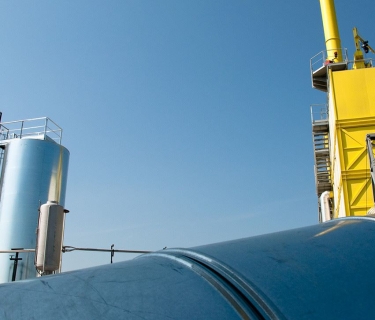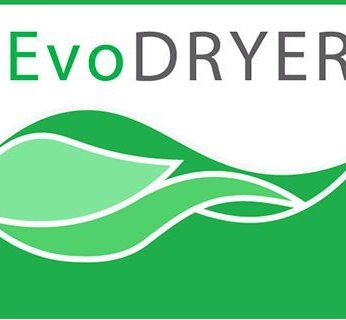
EMISSIONS INTO THE ENVIRONMENT
During the production cycle, aggregates are heated and dried to a temperature of around 160-170°, then mixed with bitumen which has also been heated to around 150-160°C. The rotating dryer drum is fitted with a burner whose flame comes into contact with the aggregates and directly heats them up. The bitumen, on the other hand, is heated separately, by convection, in special insulated tanks, through contact with electric resistances or coils in which hot oil is circulating.
The bitumen and aggregates, which up to this point have followed separate routes, are now mixed together to form asphalt in the mixer, thanks to the mechanical action of the paddles which are operated on counter-rotating shafts.
ATMOSPHERIC EMISSIONS WHICH ARE CHARACTERISTIC OF ASPHALT PLANTS ARE THEREFORE:
- conveyed emissions
produced during the ‘drying’ and ‘mixing’ phases, characterised by well-defined emission tables and limit values, which are specific for asphalt production technology.
- fugitive emissionsles émissions fugitives
produced during the loading and discharge of materials and during other phases of the overall site operation, without a specific point of measurement but which can be reduced by the use of specific solutions specially designed on the basis of each specific cause
REGULATARY LAWS
National laws
Law 152/06 is a single text regarding the environment which clearly defines the emissions (conveyed and discharged) for this type of machinery. The numerical limits relate to dust (20 mg/Nm³), sulphur oxides (1,700 mg/Nm³) and IPA (0.1 mg/Nm³).
Any other limit value, e.g. total organic carbon limit (TOC), is only referred to in the regulations regarding refuse, which use a algorithm calculation to determine C = total limit value of carbon monoxide emissions and other polluting agents.
As far as odour is concerned, it is important to note that at present no law regulates the problem in numbers, in as much as no univocal decision has yet been made. Odour emissions can however infringe the public’s rights which are protected by law.
TYPES OF POLLUTION AND METHODS OF REDUCING EMISSIONS
Dust: the main cause of dust emissions is the rock materials which are dried in the dryer drum during the production of asphalt.
The mixing tower also creates a problem of dust (a suction system keeps the screening area, hot aggregate storage, metering and mixing at low pressure) which is usually filtered in the main bag filter of the plant.
Another instance of dust formation is during the loading operations of the imported filler bin. The dust produced during this process is also filtered through a separate filter.
To reduce dust emissions at the bag filter discharge, a pre-separator or cyclones can be fitted to the filter, to separate the largest fines drawn from the dryer drum.
TO CUT DOWN THE SPREAD OF DUST EMISSIONS ON A WORKING SITE THE FOLLOWING SHOULD BE CONSIDERED:
- Wall containment on three sides of the aggregate deposits (plus a roof covering on the sand pile)
- Moistening of the general transit areas on site plus the loading and unloading areas of raw materials
- Carter protection / covering for belts transporting rock aggregates and RAP materials
- Covering for cold feeders
- Addition of small quantities of bitumen during discharge of dry materials at end of production cycle
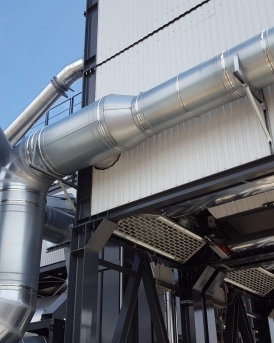
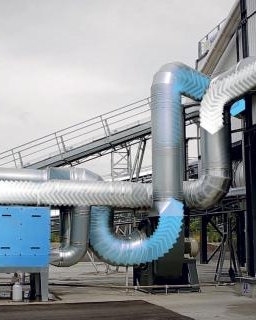
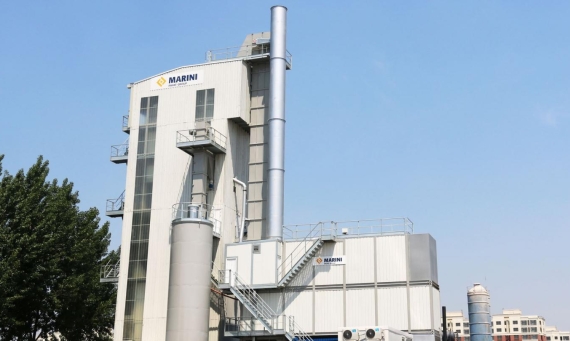
ZEROVOC
The new technology, combining the AeroFILTER with the use of the EvoDRYER system, is called ZEROVOC and results in effective and efficient fumes management plus treatment of VOC emissions.
This product , which is available at a very affordable price, is compact in terms of space but extremely effective in terms of filtering capacity and performance, making it an essential part of the plant.
Other gas emissions from asphalt plants
The use of new technologies which allow asphalt to be produced at lower temperatures have led to a reduction in both emissions and energy consumption. The production of so-called warm mix asphalts together with the various technologies for foam bitumen, with liquid or solid additives, reduce emissions significantly and also result in less aging of the bitumen and improved working conditions, not only on the production site but also on the road paving site.
THE MAIN ATMOSPHERIC EMISSIONS ARE:
- SOx :
the combustion process in the dryer drum is the principal cause of SOx formation, especially SO2, and mainly depends on the sulphur content in the fuel. Sulphur can also be contained in foundry waste. By using this type of material, an increase in emissions may well result.
To reduce sulphur oxide emissions, it is sufficient to use fuel oils with a low sulphur content.
- NOx :
the combustion process in the dryer drum also creates NOx emissions, which depend on any eventual excess of air, on the flame temperature and on the type of burner. Also nitrogen contained in liquid fuels adds to NOx emissions.
Here too, fuel oil can greatly affect emissions and therefore it is advisable to use natural gas as opposed to fuel oils.
- PAH :
polycyclic aromatic hydrocarbons are molecules made up of two or more fused aromatic rings, originating in the incomplete combustion of fossil products.
Even though the quantities are very small, bitumen contains PAH (91-95). The production process of bitumen by vacuum distillation does in fact remove most of the composites with low molecular weight. The polycyclic aromatic hydrocarbons are emitted together with the more volatile parts of the bitumen, when this is heated to a high temperature and sprayed onto the aggregates.
FURTHER POSSIBLE POLLUTANTS NOT EXPRESSLY CITED IN LAW 152/06 ARE:
- CO :
these emissions are mainly associated with the combustion process in the dryer and increase when the combustion in incorrect. Furthermore, CO emissions greatly depend on the fines content in the aggregate, the moisture content of the aggregates and the use of RAP. Therefore, when recycling it is not possible to keep CO emissions from the bag filter constant.
Combustion checks and controls reduce the emissions of carbon monoxide and so it is vital to have a correct burner maintenance and calibration. Once again, the possibility of using natural gas helps cut down emissions.
- VOC :
According to the European regulation 2004/42/CE (21 April 2004), Volatile Organic Compounds are defined as compounds which have a boiling point less than or equal to 250°C at standard pressure of 101.3 kPa.
Emissions of VOC originate in the use of liquid organic fuels and the main source of VOC emissions is incomplete fuel combustion.
The type of combustion used, the operating conditions and the bitumen vapours produced in the mixing cycle are the main factors responsible for VOC emissions.
The use of organic components in the production process (RAP use) can increase VOC emissions.
Other varying factors which affect VOC are all the times when bitumen is used at temperature in the production process: bitumen tanks during tanker refuelling operations, mixer, deposit silo belt, discharge of asphalt onto trucks. Also points of RAP heating can also be sources of VOC.
Combustion controls reduce VOC emissions.
To keep emission level low, it is important to avoid asphalt overheating: in the normal temperature range fumes emissions double every 10°C rise in temperature.
As far as the bitumen storage tanks are concerned, it is best to vent the tank exhaust through a water syphon or active carbon filter.
Final summary and limit values of pollutants
As illustrated in the above account, all asphalt plants must conform to the specific regulations of UNI EN 13108 “Construction Products” and, on the basis of present technical knowledge and the application of BAT (Best Available Techniques), they can respect the limit emission values illustrated in the following table:
POLLUANT AGENT | LEAST VIABLE FACTORS |
|
| Dust | 10 – 20 | 10 – 20 |
| Sulphur Oxide SOx | 300 – 600 | 1700 |
| Polycylic Aromatic Hydrocarbons PAH | 0,1 | 0,1 |
| Nitrogen Oxide NOx | 450 – 600 | |
| Carbon Monoxide CO | 100 mg/m³ with burner operating on natural gas 500 mg/m³ with burner operating on fuel oil | |
| VOC | 50 mg/m³ with burner operating on natural gas 110 mg/m³ with burner operating on fuel oil 150 mg/m³ with burner operating with additional RAP material |
Note: La teneur en oxygène dans le gaz est égale à 17%

